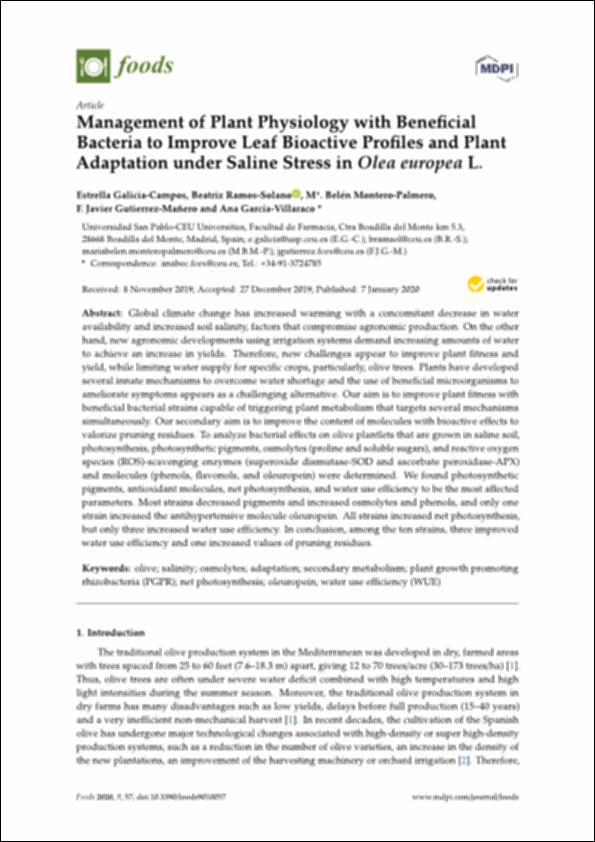Por favor, use este identificador para citar o enlazar este ítem:
http://hdl.handle.net/10637/14709Management of Plant Physiology with Beneficial Bacteria to Improve Leaf Bioactive Profiles and Plant Adaptation under Saline Stress in Olea europea L.
| Título : | Management of Plant Physiology with Beneficial Bacteria to Improve Leaf Bioactive Profiles and Plant Adaptation under Saline Stress in Olea europea L. |
| Autor : | Galicia Campos, Estrella Ramos Solano, Beatriz Montero Palmero, María Belén Gutiérrez Mañero, Francisco Javier García Villaraco, Ana |
| Materias: | Osmolytes; Adaptation; Secondary metabolism; Plant growth promoting rhizobacteria (PGPR); Net photosynthesis; Oleuropein; Water use effciency (WUE) |
| Editorial : | MDPI |
| Citación : | Galicia-Campos, E.; Ramos-Solano, B.; Montero-Palmero, M.B.; Gutierrez-Mañero, F.J.; García-Villaraco, A. Management of Plant Physiology with Beneficial Bacteria to Improve Leaf Bioactive Profiles and Plant Adaptation under Saline Stress in Olea europea L. Foods 2020, 9, 57. https://doi.org/10.3390/foods9010057 |
| Resumen : | Global climate change has increased warming with a concomitant decrease in water availability and increased soil salinity, factors that compromise agronomic production. On the other hand, new agronomic developments using irrigation systems demand increasing amounts of water to achieve an increase in yields. Therefore, new challenges appear to improve plant fitness and yield, while limiting water supply for specific crops, particularly, olive trees. Plants have developed several innate mechanisms to overcome water shortage and the use of beneficial microorganisms to ameliorate symptoms appears as a challenging alternative. Our aim is to improve plant fitness with beneficial bacterial strains capable of triggering plant metabolism that targets several mechanisms simultaneously. Our secondary aim is to improve the content of molecules with bioactive e ects to valorize pruning residues. To analyze bacterial e ects on olive plantlets that are grown in saline soil, photosynthesis, photosynthetic pigments, osmolytes (proline and soluble sugars), and reactive oxygen species (ROS)-scavenging enzymes (superoxide dismutase-SOD and ascorbate peroxidase-APX) and molecules (phenols, flavonols, and oleuropein) were determined. We found photosynthetic pigments, antioxidant molecules, net photosynthesis, and water use e ciency to be the most a ected parameters. Most strains decreased pigments and increased osmolytes and phenols, and only one strain increased the antihypertensive molecule oleuropein. All strains increased net photosynthesis, but only three increased water use e ciency. In conclusion, among the ten strains, three improved water use e ciency and one increased values of pruning residues. |
| URI : | http://hdl.handle.net/10637/14709 |
| Derechos: | http://creativecommons.org/licenses/by-nc-nd/4.0/deed.es OpenAccess |
| ISSN : | 2304-8158 |
| Fecha de publicación : | 7-ene-2020 |
| Centro : | Universidad San Pablo-CEU |
| Aparece en las colecciones: | Facultad de Farmacia |
Los ítems de DSpace están protegidos por copyright, con todos los derechos reservados, a menos que se indique lo contrario.


